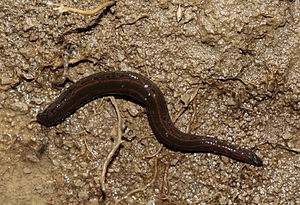Brushless leeches
| Brushless leeches | ||||||||||
|---|---|---|---|---|---|---|---|---|---|---|

Medicinal leech ( Hirudo medicinalis ) |
||||||||||
| Systematics | ||||||||||
|
||||||||||
| Scientific name | ||||||||||
| Euhirudinea | ||||||||||
| ( Lukin , 1956) |
The bristle lots of leeches (Euhirudinea, Autobdella or Hirudinida) are a subclass of the flukes (Hirudinea) to which the Rüsselegel , Schlundegel and Kieferegel include, but are not Borstenegel and Krebsegel .
features
The bristle-free leeches, like the crab leeches, have no bristles ( chaetae ) in contrast to all other annelids . They have two suction cups , a larger one at the back and a smaller one around the mouth in front, with which they can move in a characteristic way and adhere to substrate or hosts.
The body of the bristle flukes, including the always present prostomium, is divided into 34 segments, which are not externally recognizable due to a narrower ring - usually four ringlets per segment in the middle section - while the nervous system consists of 34 corresponding pairs of ganglia . The front suction cup is made up of the 4 first segments and the rear suction cup is made up of the 7 last segments. The male sexual opening of the hermaphrodite animals is in the ninth and the female in the tenth segment.
The foregut the bristle lots Egel is either vorstülpbarer fixed trunk ( Rüsselegel formed), a strong throat ( Schlundegel ) for sucking prey or with serrated jaws busy ( Kieferegel ) which serve to slit open the skin of the host.
The coelom has no partition walls and is designed as a system of channels or vessels that run between powerful muscles and connective tissue. While the proboscis have a primary closed blood vessel system within the coelom canals, it is quite reduced in the phlegm and jaw rules, and its function is here completely taken over by the system of the coelom vessels as a secondary blood vessel system.
Occurrence, habitat and way of life
The bristle flukes are parasites , often on vertebrates , or carnivores . There are aquatic, marine and land-living forms. They are common worldwide.
Systematics
EI Lukin contrasts the bristle leeches as Euhirudinea ("real leeches") for the first time in 1956 and again in 1976 in his standard work on the leeches of the USSR with the bristle leeches or Archihirudinea ("old leeches"). Peter Ax names the autapomorphism of the monophyletic group Autobdella or Euhirudinea as the constant number of 34 segments including prostomium and also 34 pairs of ganglia, the posterior suction cup being formed by 7 segments, the complete absence of bristles as a convergent development to the Branchiobdellida , the formation of an anterior one Suction cup as a consequence of the reduction of the bristles, the development of lined up testicular follicles from long sperm tubes as well as the reduction of the metameric coelom sacs and the formation of the coelom as a canal system. The bristle leeches form the sister group to the bristle leeches (Acanthobdellida) within the subclass of leeches, with which they in turn form a sister group to the crab leeches (Branchiobdellida). They include the following orders and subordinates:
- Proboscis (Rhynchobdellida)
-
Trunkless leeches (Arhynchobdellida)
- Schlundegel (Pharyngobdelliformes)
- Kieferegel (Gnathobdelliformes)
literature
- Peter Ax: The system of Metazoa II. A textbook on phylogenetic systematics. Gustav Fischer Verlag, Stuttgart / Jena 1999. Chapter Hirudinea , pp. 65–73.
- Hasko Nesemann, Eike Neubert: Annelida, Clitellata: Branchiobdellida, Acanthobdellea, Hirudinea. Spektrum Akademischer Verlag, Heidelberg / Berlin 1999. S. 21. Subclass Euhirudinea.
- Е. И. Лукин: Фауна СССР - Пиявки. Издательство Наука, Ленинград 1976. p. 11. Главные группы класса, Euhirudinea - Настоящие пиявки.
Web links
- Euhirudinea, bristle flukes in: Lexicon of Biology , online edition.